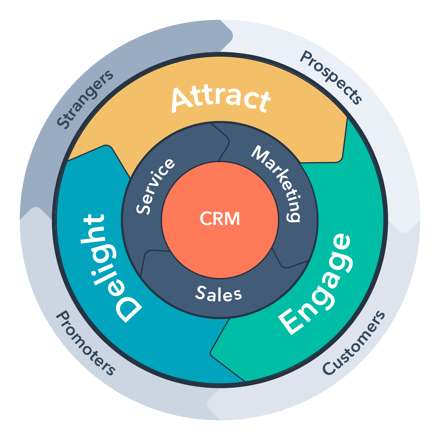Getting started with RevOps

If you’re an early-stage company and you’ve found product/market fit, scaling up is probably on your horizon. But what is the best way to scale a growing business? The answer isn’t only to hire more people so that you can acquire and service more customers – it is also to introduce RevOps processes early on and make what’s already working run even smoother.
I’ve already written in more detail about what RevOps is and why it matters to your business. In short RevOps is a way of looking at the whole customer lifecycle – from marketing and the sales process through to onboarding and customer support – and making incremental operational improvements, wherever they’re needed.
If you think of the customer journey as a flywheel, then RevOps is the oil that makes it spin faster. The faster the flywheel spins, the more revenue your business generates.
Lay the foundations with your CRM
Because RevOps examines the entire lifecycle of a customer, you have to have 360 degree visibility for it to work. That means using a CRM that breaks down the silos between the marketing, sales and customer success phases of your customer’s full buying journey.
My preferred platform is HubSpot. With “hubs” for each of those three stages combined within the same CRM, HubSpot keeps all aspects of the customer lifecycle together and visible in one place.
Whether you use HubSpot or a bolted together solution, your CRM needs to be reliably integrated with every tool in your marketing tech stack. Every communication with your marketing, sales and customer support teams – whether that’s via phone, email or support ticket – should be stored against each contact in your CRM database.
When you’ve got that comprehensive and granular view, the initial foundation for RevOps is there.
Examine the state of your customer lifecycle
The next step is building accurate reporting. Take the marketing awareness phase, for example. The marketing team might be generating a certain amount of inbound leads each month, but from which exact channels and sources? And looking further down the funnel, how many of those leads become SQLs and eventually customers? What is the activation rate from trial to paying customer? Do you have data points to determine how successful your current onboarding processes are? Without accurate metrics & reporting it’ll be tough to quantify what’s happening and therefore how and where to make improvements.
Ask yourself, where are customers getting stuck? How many touch-points in a sales cycle does it take for the average lead to convert to an SQL? How does this compare vs MQL to SQL conversion? Which ICPs are the most profitable and are your sales teams investing time and energy into chasing the right opportunities? Audit your sales cadences and your pipeline velocity. Look over the play by play of your marketing -> sales -> customer success baton passes. You need reporting to provide insight into all of these questions.
Get your marketing, sales and customer success teams working together to scope and build the reporting you need to understand and visualise your customer's lifecycle.
Reporting is how you find friction and bottlenecks. And anywhere there’s friction, there’s an opportunity for RevOps to streamline and improve the experience for your customers.
Make calculated incremental improvements
The final step to getting your RevOps process underway is to analyse reporting and then brainstorm, categorise and shortlist the ideas you've accumulated.
It could be easy for your team to come up with a million and one ideas for RevOps experiments. How do you pick which to try first? Do you start with marketing and move through the lifecycle? Pin all the ideas on a dartboard and implement the one you hit first?
Product teams and growth marketers will probably already be aware of the ICE framework, which I think works perfectly for RevOps. ICE stands for Impact, Confidence and Ease, and it’s a scoring system that helps you to prioritise your optimisation ideas.
- Impact. What impact will the refinement have on the customer experience and your operation? Do you expect it to increase the number of leads that convert, for example, or reduce cost per lead?
- Confidence. How confident can you be, based on the data you’ve collected, that the predicted impact will be the case?
- Ease. How easy will that change be to implement? What will it take in terms of time and resources?
By evaluating ICE and giving each a score out of ten, it becomes much easier to narrow down which experiments to tackle first.
RevOps example for inspiration
To give you an idea of how RevOps can make improvements in practice here is a high level example.
Scenario:
Let's imagine your analysis of reporting shows that MQL to SQL conversion rate (inbound) is reliably higher than prospected Lead to SQL conversion rate (outbound). You might want to capitalise on this trend and put in place automation and processes to generate more MQLs and to ensure that no MQLs fall through the cracks.
Your teams then brainstorm some ideas which are categorised and given ICE scores.
- Marketing. If a contact downloads a white paper from your website or registers for a Webinar, automation can immediately send a notification to your marketing team to research their business further to determine if the lead fits your ICPs or not, so that the Company Type is updated accordingly. This in turn will filter out any low quality form completions allowing only true MQLs to be prioritised. High-value MQLs can then be automatically routed to your sales team to target. You might also have lower priority MQLs routed away from the sales team into automated lead nurture.
- Sales. MQLs that have been quality checked and enriched by the marketing team are automatically assigned to relevant sales reps. Sales reps can then enrol MQLs into sales sequences where for example, relevant sales collateral such as ICP based case studies and/or persona-based messaging are included in the email templates. Tasks are automatically set to follow up. Target account MQLs can be ear-marked for hyper-personalised video outreach and automatically added to ABM Ad Audiences on paid social.
- Customer success. Closed won customers can be enrolled into automated onboarding tailored to the ICP which might include referral incentives. After successful onboarding NPS surveys can be run to help find evangelists to approach for case studies and testimonials which in turn can be used by marketing to generate more MQLs.
With RevOps identifying how manual processes can be improved via automation, no leads end up falling through the cracks and only actual leads (that fit your ICP criteria) are prioritised.
Conclusion
As you can see RevOps isn’t about making anyone work harder or faster. It’s about getting more traction from the energy and effort your teams are already putting in to make the flywheel spin faster. It's about finding and removing hidden micro inefficiencies and creating momentum across the customer lifecycle.
If you’re looking to introduce RevOps to your business, check out my blog posts on implementing HubSpot across your whole customer lifecycle and setting up accurate data reporting. With those foundations and the right ethos in place, you’ll be well on your way to getting started.


.png?width=352&name=How%20to%20Add%20Schema%20to%20Your%20HubSpot%20Website%20(and%20Why%20It%20Matters%20for%20AEO).png)
